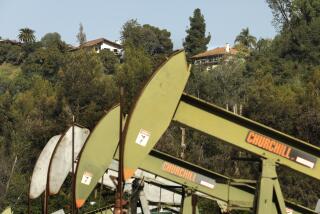Shell seeks more time to drill exploratory well in Chukchi Sea
GIRDWOOD, Alaska — With its bid to launch offshore drilling in the Arctic Ocean running up against a deadline to protect against sea ice, Shell Alaska has requested an extension in its window for drilling in the Chukchi Sea.
Peter E. Slaiby, vice president of the Alaska venture, said Sunday that the company has proposed extending the time allowed for drilling in the Chukchi by slightly less than two weeks beyond the Sept. 24 deadline set by the U.S. Department of Interior to allow time for cleanup of any oil spill before the onset of winter sea ice.
Meeting with reporters at an Arctic Imperative Summit here, Slaiby said the company’s latest models for forecasting the onset of winter sea ice now show the first freeze-up occurring somewhat later than originally envisioned when federal officials imposed their initial deadline for ending operations in the Chukchi Sea.
Drilling in the Beaufort Sea, closer to shore, already is allowed through Oct. 31.
A deadline extension is important for Shell, which has spent more than $4.5 billion on preparing to drill its first exploratory wells off the coast of Alaska in more than 20 years. With only a few weeks before the current cutoff for drilling, Shell has yet to receive its final federal permits.
The result has been a nail-biter for the global energy company, which is facing the possibility of missing yet another full drilling season in the Alaskan Arctic and postponing operations until 2013.
Shell now expects to complete no more than one well in each of the Beaufort and Chukchi seas this year -- if that.
“What we’ve done is, obviously, we’ve looked at the language we got in the approval of our exploration plan and we’ve looked at the most likely date for ice formation in the Chukchi Sea, and that does give us some additional back-in time,” Slaiby said.
The primary obstacle to launching operations has been completion of a vessel to carry and deploy an oil containment system in the event of an oil spill. That vessel, the Arctic Challenger, has been delayed in shipyards at Bellingham, Wash., undergoing a complex retrofit that has been marred by repeated complications and delays.
Slaiby said Sunday he expects that the Arctic Challenger’s construction and certification could be completed by the end of this week, allowing the vessel to embark on the two-week journey to the Arctic.
“It could happen quickly. We’re very optimistic,” he said. “We’re down to very, very little left [to complete before U.S. Coast Guard certification]. “We see now that there’s no real showstoppers. What needs to be done, it’s really just a question now of finishing up some pretty basic stuff to get it ready.”
Rear Adm. Thomas P. Ostebo, commander of the U.S. Coast Guard’s 17th District in Alaska, told the Los Angeles Times Sunday that sea trials for the Arctic Challenger are expected to take place Wednesday or Thursday.
“As far as the COI [certificate of inspection], they could be underway by the end of the week or early next week,” he said.
As recently as last week, Coast Guard spokesman Jamie Frederick told The Times, “significant deficiencies” still existed “on several safety and operating systems.” But engineers at Superior Energy Marine Technical Services, which is undertaking the overhaul, have been working hard to make required fixes.
Slaiby said Shell has sent a letter to the Interior Department suggesting that the company’s reading of its permits could allow Shell to start the drilling of top holes — not touching any hydrocarbon areas — while the Arctic Challenger is en route to the Arctic.
“There’s no disagreement, there’s no dispute. We said we would have that [oil containment system] ready when we get into hydrocarbon zones,” he said.
If the company is not able to reach hydrocarbon zones by the original deadline of Sept. 24 in the Chukchi Sea, he said, engineers might, under Shell’s proposal, begin drilling top holes for the 2013 drilling season, scheduled to be undertaken next summer.
“We would not be allowed to deepen a well into hydrocarbon zones after Sept. 24,” he said.
The Interior Department’s Bureau of Ocean Energy Management has not yet responded to Shell’s communications, he said, but the company is hoping federal officials will heed Shell’s argument that the Arctic Challenger is a fourth-level or fifth-level oil spill response system, behind a large array of equipment designed to quickly shut down any well in the event of an uncontrolled release.
“There’s no real mission [for the oil containment system on board the Challenger] per se, as long as you have the capping stack,” he said, referring to a metal-to-metal cutoff device, similar to the one that ended the Deepwater Horizon blowout in the Gulf of Mexico, that already is prepared to deploy in the Arctic.
ALSO:
Grizzly bear kills hiker in Denali National Park
Armstrong: a never-read eulogy recalls danger of his feat
Neil Armstrong: His Ohio hometown mourns a local legend
More to Read
Sign up for Essential California
The most important California stories and recommendations in your inbox every morning.
You may occasionally receive promotional content from the Los Angeles Times.










